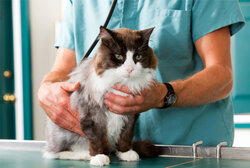Cat Flu – Symptoms & Treatment
Cat flu is characterised by, among other things, watery eyes and frequent sneezing. The best protection against this illness is early vaccination. If an unvaccinated cat becomes ill, it should be taken to the vet to improve its current state of health and minimise the risk of any secondary complications.
How do cats catch cat flu?
It is exactly the same as with humans: the greatest danger of a cat contracting cat flu is when it comes into contact with another cat that is infected with the illness. Least at risk are therefore single cats that are always kept indoors. This should not, however, be a reason for just having one cat, and never letting it go outdoors. Many cats are allowed to go outside and will have frequent contact with other cats. If an infected cat sneezes or coughs in close proximity to another cat, if it licks it, eats from its bowl, or if there is any other droplet or smear transmission, then infection will occur.
What are the causes of cat flu?
Cat flu is also referred to as the cat flu complex. This term is used because there are many possible causes of the illness. Both bacteria and viruses can be involved – and sometimes several of them at the same time. The main causes are feline calici and herpes viruses, as well as the bacteria Chlamydia felis and Bordetella bronchiseptica (which causes kennel cough in dogs). They can occur in various combinations, enhancing each other and causing a variety of symptoms.
Typical symptoms of cat flu
Depending on which viruses and bacteria are involved in cat flu, different symptoms occur. Typical symptoms are:
- Frequent sneezing
- Nasal discharge
- Watery, crusty eyes
- Breathing problems
- Fever
- Loss of appetite
- Difficulty swallowing
- Heavy salivation
- Weight loss
- Fatigue
- Ulcers in the mouth
What cats are particularly at risk?
Because transmission usually occurs from animal to animal, cats that are allowed outdoors and pets that live in households with more than one cat are particularly at risk. The greatest danger here is for kittens under four months of age, as well as for older cats and all those whose immune systems are weakened, for example due to an illness.
Is cat flu contagious?
Cat flu is highly contagious, so special precautions should be taken in the event of a suspected infection or confirmed diagnosis. In a household with more than one cat, the pet affected should be separated from the other cats. If it is usually allowed outdoors, it should be kept inside for the time being to avoid other cats becoming infected.
Although it is highly unlikely, it is possible for cat flu to be transmitted to humans. As with cats, children and sick and elderly people are more likely to be infected than healthy adults. It is therefore always advisable to avoid overly close contact with the cat and to wash your hands if it has licked you.
How does the vet make a diagnosis?
Cats suspected of having cat flu should be taken to a vet as soon as possible to improve their state of health and to reduce the risk of any secondary complications. If multiple typical symptoms are present, for example sneezing, a runny nose and watery eyes, the diagnosis is simple. In order to be certain, however, the vet will carry out a more thorough examination, which may include a swab of the mucous membranes, a blood test and listening to the lungs.
How is cat flu treated?
Cat flu cannot be compared to the minor colds that humans also have from time to time. It is more comparable to full-blown influenza. If the condition is left untreated, it can become chronic. In addition, it can lead to damage to the eyes and pneumonia. Sadly, there is no medication that can combat viruses, however there is against bacteria, which can be treated with antibiotics. If the cat is not drinking and/or eating enough, it can be fed intravenously to build up its strength. In addition, the vet can prescribe an expectorant and cough medication, and treat any inflammation. The immune system can also be strengthened using conventional medicine or homeopathy.
What home remedies are there for cat flu?
A cat suspected of having cat flu should always be taken to the vet. They will tell you what measures you can take in addition to administering the medication. This can include, for example, regularly cleaning your pet’s eyes and nose with a saline solution. You should also make sure that your cat has plenty of peace and quiet, that it has no contact with other cats and that it is nice and warm. High-quality food and its favourite treats can also help your cat to develop an appetite and quickly regain its strength.
Prevention through vaccination!
The best way to protect your cat from cat flu is by having it vaccinated. Most veterinary medicine authorities recommend that this is carried out as part of the routine vaccination schedule. This involves vaccinating kittens against cat flu in order to build up defence mechanisms at an early age. The vaccination will normally be shown in the cat’s vaccination certificate with the name “RCP”, which includes the cat flu vaccination as well as the vaccination against feline panleukopenia. Kittens are usually vaccinated at 8, 12 and 16 weeks of age, during which time the natural protection they receive from their mother’s milk will gradually diminish and they will begin to build up their own natural protective mechanism. Basic immunisation is completed with a vaccination at the age of 15 months. Depending on how high the risk of infection is deemed to be, a booster vaccination can be recommended every one to three years. This is something you should discuss with your vet.
You may also like this

Having your cat vaccinated
Vaccinations at an early age ensure good protection

Cats’ eyes
Many eye disorders can only be treated effectively early on

Dental care for cats
This is what a dental care of your cat can look like

Blood pressure in cats
Measuring blood pressure reveals the efficiency of the heart
